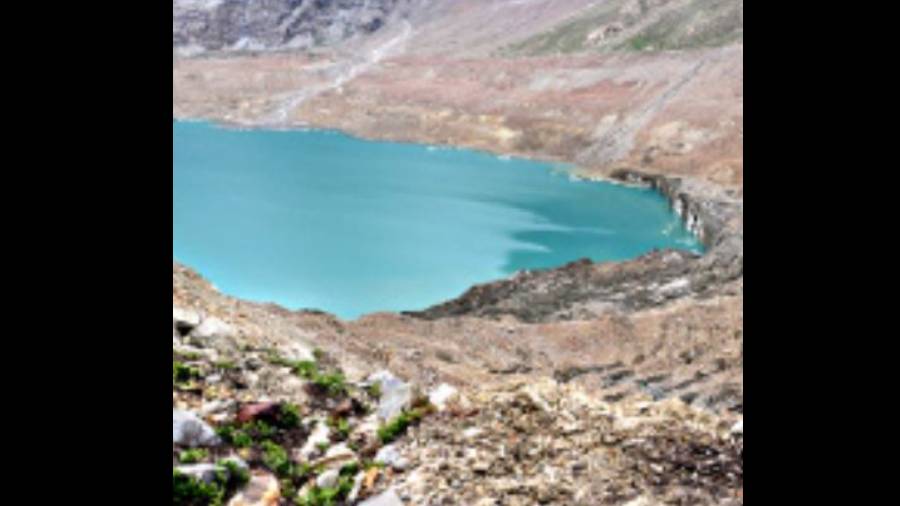An ice or rock avalanche into a Himalayan glacial lake named Gepang Gath could send massive flash floods into Sissu, a tourist village in Lahaul valley in Himachal Pradesh, scientists have cautioned, proposing risk-reduction measures.
The scientists have estimated that a lake burst at Gepang Gath, triggered by a large or moderate-sized avalanche, could send a devastating wall of slush and water 8.5km downstream into Sissu, a tourist site for camping and trekking.
The village is 40km from Manali.
The researchers used satellite imagery and computer simulations to assess the hazard of a glacial lake outburst flood (Glof).
They have calculatedthat geo-engineering measures that reduce the lake’s depth by 10 to 30 metres would lower the risk to Sissu and its neighbouring croplands.
“Reducing the lake depth would still not completely eliminate the risk,” said Ashim Sattar, a scientist at the Indian Institute of Science, Bangalore, who led the study.
“Further risk reduction could be achieved through early warning systems, including sensors installed at the lake, and through effective community awareness.”
Scientists have observed for years the growth of glacial lakes in the Himalayas and elsewhere in the world. As glaciers recede amid global warming, melt-water accumulates at the front of the glaciers, causing lake volumes to grow. The water is held back by natural barriers provided by unconsolidated rock and sediments.
But the natural barriers can sometimes abruptly collapse, leading to a fast-flowing Glof that can carry large volumes of water and debris kilometres downstream within minutes, causing damage to infrastructure, property and crops. An ice or rock avalanche into a glacial lake is one possible trigger for a Glof.
Sattar and his research collaborators at the IISc and other institutions in India, Austria, Switzerland and the US used satellite imagery to identify vulnerable areas downstream of Gepang Gath and computer simulations to estimate the volume of water a Glof would discharge.
Their study suggests that a large-volume avalanche into the lake could send a 13-metre wall of water, gushing at 70,000 cubic metres -- sufficient to fill up 28 Olympic-sized swimming pools -- per second into Sissu.
A moderate-volume avalanche would send a seven-metre wall of water, flowing at 8,000 cubic metres – three swimming pools -- per second into the village.
The flood would last several minutes in Sissu, the study has suggested.
The Gepang Gath is surrounded by permafrost -- frozen ground -- which degrades over time and makes the area susceptible to avalanches.
"An avalanche itself is an unpredictable event -- we can tell an area is vulnerable, but the timing and magnitude are unpredictable," Sattar said.
The researchers simulated multiple scenarios with different kinds of avalanches (including varied compositions of rock-ice avalanches) crashing at different sites in the lake. All of them showed that Sissu was potentially exposed to high-intensity Glofs.
The findings have just been published in the Journal of Geophysical Research, Earth Surface.
The calculations also showed that under various avalanche scenarios, reducing the lake depth by 10 metres would shrink the vulnerable area by up to 63 per cent, while lowering the depth by 30 metres would reduce the affected area by up to 93 per cent.
“The exact process through which the water could be drained would depend on the local geology and terrain,” said RAAJ Ramsankaran, associate professor of civil engineering at IIT Bombay and study team member.
Geo-engineers had earlier attempted to drain glacial lakes in Nepal and Bhutan.
One option would be to use a network of pipes and gravity to siphon some of the water out of the lake and into a river in a controlled manner, said Anil Kulkarni, a glaciologist at the IISc and another team member.
“Such engineering projects will take time to plan and execute. Our study is intended to draw the attention of policymakers to options that they could examine,” Kulkarni said.
Scientists at Newcastle University had in an independent study last month suggested that four countries -- India, Pakistan, China and Peru -- account for half of the 15 million people worldwide estimated to be exposed to the risk of flooding from glacial lakes.











